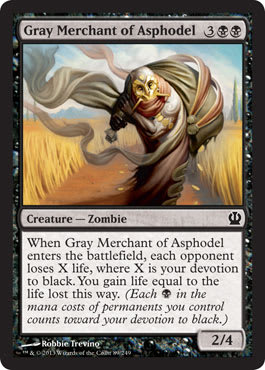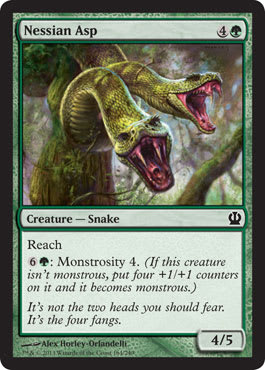I originally intended for this to be a Theros Sealed Pro Tour Qualifier report, but as I went 0–2-drop with a very mediocre pool, there wouldn’t be much value in it. I’ll just have to be comfortable with the knowledge that I finished dead last in the largest PTQ ever (three hundred ninety-five players). Instead, I’ll share what I’ve learned over the course of the past week during my attempts to master the format.
First, Theros Draft and Theros Sealed are two very different animals. That’s going to be true for most sets, but it’s especially true here. Sealed tends to be slow, with many games progressing well into double-digit turns, although some pools are able to support highly aggressive decks. Draft tends to be quite fast since the creatures are insane (more on that later) and the removal is really bad. I haven’t done enough Drafts to know what the best archetypes are yet, but these are some of the decks I’ve seen do well.
Black Devotion
Key Commons and Uncommons:
- Disciple of Phenax
- Gray Merchant of Asphodel
- Keepsake Gorgon
- Lash of the Whip
- Pharika's Cure
- Read the Bones
- Sip of Hemlock
This deck is based on abusing Gray Merchant of Asphodel as much as possible, so you really want to maximize the number of black mana symbols in your permanents. By itself, it’s already solid, but any time you’re able to drain for 4 or more, it’s quite good. This is why Disciple of Phenax is a reasonably high pick in this deck. It adds 2 to your devotion to black, and the rest of your deck will make its ability a lot better. There are a couple different ways of going about drafting this deck. You would think that Gray Merchant wouldn’t fit that well into an aggressive deck, but it can do a good job of burning your opponent out, even if the body isn’t that impressive. You can pair black with any other color so long as you don’t stretch your mana too far. If you’re planning on casting Pharika's Cure and playing Arbor Colossus in your deck, you’re going to have a bad time. I wouldn’t suggest going mono-black, though, as black’s creatures are pretty lame for the most part. It’s hard to keep up a high devotion when you’re forced to trade off all of your creatures just to stay alive.
Unsurprisingly, I like the version of this deck that splashes blue the most. All joking aside, blue has bounce spells that can slow down your opponent or let you rebuy your Gray Merchants, and it has access to some nice card selection. If you want to go aggressive, red might be your best bet, especially if you manage to draft a Kragma Warcaller or two.
Blue Tempo
Key Commons and Uncommons:
Sea God's Revenge is probably the best nonrare in the set. The card is just absurd. If you have any kind of a board presence, you win the game on the spot. And just in case you don’t immediately win, you get to scry 1 because, hey, why not? Blue’s “removal” spells are better than any of the actual removal spells in the set, but they tend to work best in aggressive, tempo-oriented decks. It’s often hard to lose if you play a Vaporkin on turn two followed by another beater on turn three if you are then able to get rid of anything remotely threatening with a Voyage's End or a Griptide. These spells punish your opponent for sinking mana into a monstrosity creature, they trump any kind of combat-step shenanigans, and they send any would-be heroes back to where they came from. Thassa's Emissary is particularly good here, as you will have many ways of pushing it through, which only compounds your advantage. Plus, if you’re bestowing it, there’s a good chance you’ll have access to some form of evasion.
I’ve had some success with drafting this style of deck with green as the other color. Nessian Courser is at a perfect spot in the curve if you want to leave Griptide up. I like it more than I like Agent of Horizons since having 3 toughness is extremely relevant on defense. Blue and green have a lot of monstrosities, and that plays well with having so many instants in the deck—you’ll generally have something to do with your mana if you decide not to cast your spell on your opponent’s turn. Also, bestowing Nimbus Naiad onto any reasonable, large green creature is a big game. U/R works as well, as red has access to some beefy creatures of its own and you get full use out of Crackling Triton.
R/W/U Heroic
Key Commons and Uncommons:
- Arena Athlete
- Battlewise Hoplite
- Coordinated Assault
- Dauntless Onslaught
- Nimbus Naiad
- Observant Alseid
- Phalanx Leader
- Sea God's Revenge
- Triton Tactics
- Wingsteed Rider
These tend to be base-white decks, and you’ll typically want either blue or red as a second color. The game plan here is to go aggressive and punish your opponent as much as possible for making bad blocks. Coordinated Assault and Dauntless Onslaught lead to a lot of blowouts. Even if your opponent knows you have it, there will often not be a profitable block for her. You’ll typically want to pick up as many bestow creatures as possible, but the best common ones are Nimbus Naiad and Observant Alseid because of their cheaper bestow costs. The former is a bit better since flying is usually better than vigilance. The blue version of this deck has a lot of overlap with the G/U deck I discussed above. Voyage's End and Griptide are going to be good in any deck that can cast them, and a deck that has a bunch of heroes is going to want a Sea God's Revenge just as much as a deck full of green monsters. This is a deck that I’m always scared to tap out against, for fear that a bunch of damage will come out of nowhere. It makes me wish there were some sort of Pyroclasm effect, but I guess I’ll have to settle for the odd time I pick up an Anger of the Gods.
R/G Monsters
Key Commons and Uncommons:
- Ill-Tempered Cyclops
- Lightning Strike
- Nemesis of Mortals
- Nessian Asp
- Rage of Purphoros
- Stoneshock Giant
- Time to Feed
- Voyaging Satyr
This deck is a bit slow and midrangey, but boy does it ever pack a wallop in the late game. Nessian Asp is arguably green’s best common creature, and it’s easy to see why. Most removal spells don’t kill it, most creatures can’t attack past it, and once it becomes monstrous, it turns into The Abyss. Green and red have a reasonable number of decent early drops, so combined with Lightning Strike and Spark Jolt, you’ll be able to survive the early game. Red and green have a lot of rares that work very well in this deck, such as Polis Crusher, Ember Swallower, and Arbor Colossus. Stoneshock Giant is like a more expensive Sea God's Revenge, which is still pretty darn good. Like the blue sorcery, you will frequently win the game the turn you activate it.
Since this deck is very mana-hungry, I would never run fewer than eighteen lands. Even running nineteen lands isn’t something I’d dismiss out of hand. For the same reason, I value Voyaging Satyr highly in this deck. If there’s a deck Karametra's Acolyte is good in, it’s this one. Most decks won’t have much of a use for ramping up their mana at that stage of the game, but if you have a bunch of monstrosities, it becomes far more attractive.
I’ll have more to say about Theros Limited as I have the opportunity to draft it more. So far, it seems like a fun and skill-intensive set, and I’m glad there’s a good chance that I’ll actually be able to play in a Grand Prix in this format. Next week, I’ll be shifting gears back to Constructed as I examine the best-performing Standard decks from Pro Tour Theros.
Until next time, good luck in your drafts.
Nassim Ketita
arcticninja on Magic Online
http://www.youtube.com/nketita


























